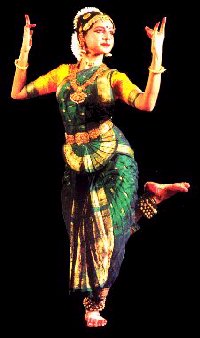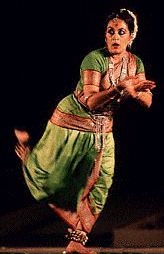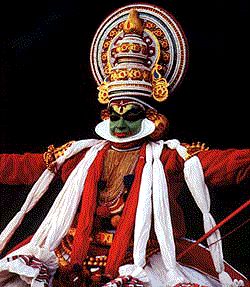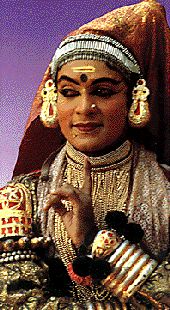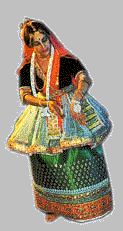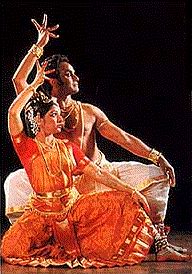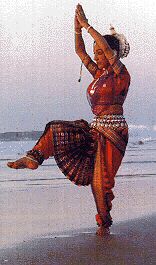Indian classical dance is inseparable from the culture of the country.
There are six forms of dances: bharata natyam, kathak, kathakali, manipuri, kuchipudi and odissi. They come from the Vedas and the Natyashastra, which is the sacred collection where the dramatic art is codified. The religious aspect is therefore very present in the Indian dance. There are, of course, many other forms of semi-classical dances. We can cite the bhagavatha mela, the mohiniattam, the kuravanci, etc ...
The bharata natyam
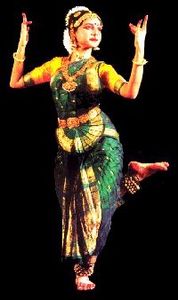
Dancer of bharata natyam
Originally from southern India, bharata natyam is considered the oldest form of Indian classical dance. Formerly it was only interpreted in temples by dancers (the devadasis) who had dedicated their lives to their art and to the gods. Today it has disappeared from the temples and won the stage.
It is a solo dance whose learning is very long and very difficult. It is taught to young girls, and sometimes to young boys, by gurus (the nattuvanars).
The choreography is composed of six paintings whose order has been established by tradition. The dancer uses her whole body but also her face and her eyes. It follows the rules of nritta for all that concerns the body gesture itself, and the rules of nity for the composition of emotions by the expressions of the face and gestures (the mudras).
The stage is also organized precisely. To the left of the stage, seen from the public, are the musicians and the singer (s) led by the nattuvanar who prints the rhythm with small cymbals (talam). The rhythm of the dance will be supported by a percussionist using a mridangam. The orchestra may consist of a flute player and a vina. The music is carnatic. To the right of the stage is a statue of Shiva in the form of Nataraja, the god of dance. The dancer enters by the right, salutes the divinity, the stage, the musicians and the public.
Today the performance lasts between two and three hours.
The most famous modern dancers in India are: Rukmini Devi, Yamini Krishnamurthi, Shanta Rao, Sonal Mansingh. Among the great professors of bharata-natya are: Minakshisundaram Pillai, Chokkalingam Pillai, Ram Goppal. One of the biggest male dancers in the world is Raghunath Manet, who has performed the male dance performing around the world.
The kathak
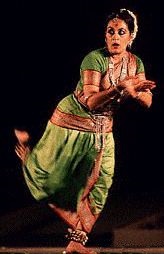
Dancer of Kathak
In Sanskrit, kathak means "history". Originally from northern India, the kathak underwent the influence of Muslim art brought by the Mughals. It is a very rhythmic dance whose musical accompaniment is very important since it prints the cadence to the dancers. For this reason the musicians use percussion instruments (tabla, pakhawaj) but also instruments more melodic (sitar, harmonium ...). The dancers respond to the music with little bells that they carry to the ankles. A singer sits on the stage and tells a story based on mythology. There are three styles of kathak: the jaipur ghanara, the lucknow ghanara and the ghanara banaras.
The dance begins slowly and then, as the performance progresses, the rhythm accelerates. The choreography of the kathak is less rigid than that of bharata natyam and leaves room for a little improvisation. The dancer must have a very great mastery of his body in space, be very fast and keep enough grace to transcribe the emotions. The choreography alternates with pirouette movements and statuesque poses. The kathak, unlike the bharata natyam, puts more emphasis on the movements of the dancer's feet than on the gesture of the hands.
The most famous kathak performers are: Shambhu Maharaj, Sunder Prasad, Birju Maharaj, Damayanti Joshi, Gopi Krishan.
The kathakali
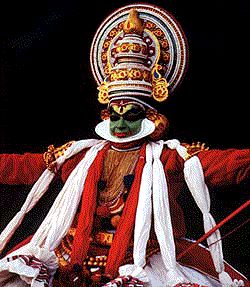
Dancer of Kathakali
Katha means "history" and kali "game". This dance was born in the seventeenth century in Kerala, state of the extreme southwest of India. Although its origins in various forms of local dances, the kathakali is quite original and has its own rules. The characters performed on stage are kings, gods, heroes appearing in the Mahabharata, the Ramayana and the great religious texts.
The kathakali is danced only by men, even for female roles. He distinguishes himself from other classical dances by the complexity of his costumes and the extravagance of the make-up of the dancers. The colors and costumes used reveal the personality of the characters who are classified into seven categories: the pacca (green) which is the hero; the katti (dagger); the chokannatidi (red beard) which is the demon; the velupputadi (white beard) representing the god-monkey Hanuman; the karupputadi (black beard) who is the hunter, the kari (black) who is the witch and the minnukku who represents women, brahmans and sages.
The lotions and powders used for make-up are made from natural elements and can be applied for several hours. The dancers place an eggplant seed on the eye to make it bloody.
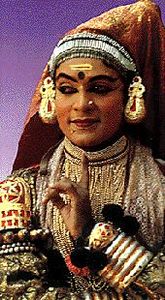
Dancer of Kathakali
The dancers are accompanied on stage by musicians and by one or two singers. The musical instruments used are maddalam (a horizontal drum), cenda (a vertical drum), itekka (a small drum) and a harmonium.
Kathakali is a very narrative dance, much more so than other classical Indian dances. Emotions and expressions are transmitted by the dancer thanks to very complex movements of the hands, legs, feet and eyes and extreme precision. The mastery of this gesture requires years of learning, a great memory and a great flexibility. Formerly, a representation of kathakali lasted all night. Modern choreographies shortened this time to two or three hours.
The most famous kathakali dancers are: Chandu Panikkar; Kunju Kurup, Ramunni Nair, Kalamandalam Krishna Nair, Gopi Nath, Krishan Kutty.
The manipuri
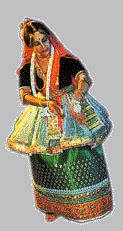
Dancer of Manipuri
Originally from the state of Manipur, in northeastern India, manuri has long been confined to this mountainous region. Always played in the temples, this dance is still very close to the life of the local population.
The manipuri dancers wear sails and a wide dress on which are placed hundreds of small circular mirrors. They have a slow rhythm. Unlike other forms of Indian dances, the dancer's face remains motionless. She is accompanied by a percussionist who dances topless while playing her instrument, the pung. Compared to the dancer, her pace is much faster, see frantic. There is, therefore, a very strong contrast between the dancer's hustle and the strength of the man.
The most famous interpreters of manipuri are Atomba Singh, Amubi Singh.
The kuchipudi
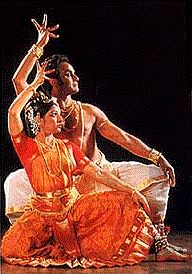
Dancer of Kuchipudi
The Kuchipudi originates from the south of India, more precisely from the village of Kuchipudi (Kuchelapuram) in the state of Andhra Pradesh. Like most dances, it used to be played in temples and in groups. Originally it was even reserved for Brahmins who held the female roles. The traditional training of dancers lasts about seven years. Today, kuchipudi is also danced by women and sometimes solo.
The performance begins with traditional prayers and offerings. The dancers present themselves with a daru. The daru is a small danced scene that highlights the personality of the characters and the skill of the dancers. These are distinguished by their make-up and their costume.
The kuchipudi is renowned for the fluidity of the movements of the dancers and the rhythmic music of the carnatic type that accompanies them. The orchestra is composed of musicians (mridangam, flute, cymbals, harmonium), a singer and a nattuvanar who directs the whole. The choreography is based on rhythmic gestures and facial movements. Occasionally, there may be dialogues between the dancers.
Numerous figures compose a representation. One of the most well-known repertoires of the repertory is that in which the performer dances on the edges of a copper tray while swinging dexterously a pot filled with water above his head, without spilling a drop of course! This is tarangam. The most famous kuchipudi interpreters are: Yaamini Krishnamurthy, Swapnasundri, Radha and Raja Reddy.
The Odissi
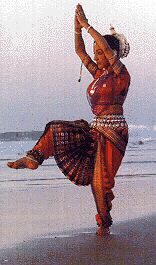
Dancer of Odissi
The odissi comes from the state of Orissa, in the east of India. More than 2000 years old, dance originated in the cult of Krishna. Sculptures depicting odissi dancers have been found on the walls of some temples such as Konarak and Puri.
The odissi is very faithful to the choreographic traditions of the Natyashastra. The dance rests on the principle of the tribhang which divides the body of the dancer into three parts: the head, the bust and the torso. It is the complicated movements of these parts of the body that pass emotions and expressions. They are difficult to execute and require very high precision from the dancer.
A typical recital contains one or two ashtapadis which are poems in Sanskrit, taken from the Gita Govinda, and whose theme is the love between Krishna and Radha. Their interpretation by the dancer is a subtle blend of pure dance and expressive dance. The accompanying music is made of carnatic and hindustanic music. The most famous performers are: Kelu Charan Mahapatra, Indrani Rehman, Protima Gauri Bedi.
See also:





